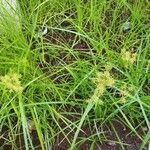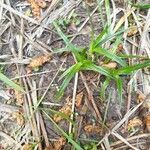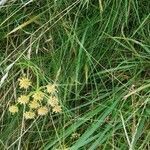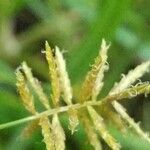Herbs, perennial, stoloniferous; stolons soft, spongy, flexible when dried, 2–8(–15) cm, bearing tubers (3–)6–11 mm diam. Culms trigonous, 15–60 (–100) cm × 0.6–3.4 mm, glabrous. Leaves 3–7, flat to V-shaped or flanged V-shaped, (6–)20–40(–80) cm × 2–4 (–6.5) mm. Inflorescences: spikes broadly ellipsoid to ovoid or hemispheric, (12–)18–30 × (12–)18–35 mm; rachis 4–17 mm; rays 4–10, (0.3–)2–12 cm; bracts (3–)4–5(–7), ± horizontal to ascending at 45(–75)°, V-shaped to flanged V-shaped, (1.5–)5–30 cm × 0.5–4 mm; rachilla persistent, wings hyaline, 0.3–0.5 mm wide. Spikelets (3–)10–20(–28), divaricate or ascending, yellowish brown to dark brown, linear to linear-lanceoloid, compressed-quadrangular, (5–)10–20(–55) × (1.2–)1.4–2(–3) mm; floral scales persistent, 6–34, spreading or appressed, ovate-lanceolate, laterally 7–9-ribbed, laterally yellowish brown to dark brown medially brownish, reddish, or greenish, ovate, or ovate-deltate, medially 3-ribbed, 1.8–2.7(–3.4) × (1–)1.5–1.8(–2.4) mm, apex acute or sub-acute. Flowers: anthers (1–)1.2–1.5(–2.1) mm; styles (0.7–)1–1.2(–2.2) mm; stigmas (1.2–)1.8–2.3(–4) mm. Achenes (seldom maturing) brown, sessile, ellipsoid, (1.1–)1.3–1.5(–1.6) × 0.3–0.6(–0.8) mm, apex obtuse, surfaces puncticulate.
Sweet-scented perennial with numerous slender rhizomes ending in small tubers; stems stout, triquetrous, 1–7 dm, smooth; lvs basally disposed, elongate, 3–8 mm wide; at least the lower invol bracts surpassing the infl; rays usually several, to 7 cm but more often not surpassing the sessile spikes, often again branched at the top; prophyll obliquely truncate or prolonged 1–3 mm beyond the orifice; spikes numerous in short-cylindric spikes, slender, 0.5–5 cm, only 1–2 mm wide, with 8–30+ fls; scales yellow-brown, (2–)2.5–3(–3.5) mm, thin, scarcely keeled, ovate, acute, conspicuously 7–9-nerved; rachilla persistent, narrowly hyaline-winged; achenes oblong, unequallytrigonous, 1.3–2 mm, tan to golden-brown; 2n=108. Damp or wet soil, sometimes a weed; widespread in trop. and temp. (but not cold-temp.) regions, and nearly throughout our range.
Rhizomes weak, filiform, terminated by hard tubers. Stems to 40 cm high, 3-angled, leafy and ± bulbous at base. Leaves < or > stems, 3-8 mm wide, flat, pale green, margins recurved, scabrid; sheaths reddish-brown. Involucral bracts 4-6, leaf-like, lowest 1-2 > inflorescence. Inflorescence yellow-brown, a simple to compound umbel; rays c. 6, unequal, longest to 10 cm. Spikelets ± 10-15 × 2 mm, linear-oblong, much compressed, in lax ovate spikes at ends of rays. Rhachilla winged. Glumes ± 2.5 mm long, not closely imbricate, ovate, scarcely keeled, tip obtuse or slightly mucronate, yellow-brown, distinctly nerved. Stamens 3. Style-branches 3. Nut ± ½ length of glume, obovate-oblong, trigonous, light brown.
Perennial herb, aerial parts deciduous, 0.12-1.00 m high, rhizomes slender. Leaf blades 5 mm wide, flat. Culm scapose, 3-angled, 1-5 mm in diam. Inflorescence a compound anthela, 50-150 mm in diam., with 4-12 spreading spikelets, spicately arranged on ends of stalks. Subtending bracts 3 or 4, leaf-like. Spikelets compressed, oblong, 8-12 x 2.5 mm, 8-14-flowered. Glumes imbricate when young, bases distant at full maturity, lanceolate with obtuse apex, ± 2.8 mm long, keel excurrent into a minute point. Flowering time Nov.-Feb. Nutlet (mature ones seldom collected) obovate to elliptical, 1.3-1.5 x 0.7-0.9 mm, 3-angled, faces frequently sulcate, dark brown appearing grey, surface minutely reticulate.
An upright grass like sedge. It continues to grow from year to year. It is usually 30-90 cm high. The leaves are long and narrow. They are shiny. The leaves are arranged on 3 rows around an angular stem. The leaves often have a pointed tip. The leaves are light green. The flowers are yellow spikes. They are 1-1.5 cm long. There are many creeping underground stems (rhizomes). These spread out then end in a swelling. This tuber is round and 5-20 mm long. It has a thin brown skin. They are crisp and nutty.
Plants perennial, with long stolons ending in small tubers; the culms 10-60 cm. high; inflorescence of 5-10 lax heads on simple or compound rays; leaves 2-7 mm. wide; bracts leaf-like; the spikelets linear, 5-12 mm. long, yellowish, scales not carinate, many-nerved; achene obovate-oblong, 1.5 mm. long, trigonous, with concave sides, dull gray, minutely reticulate.
A fairly robust, stoloniferous, perennial herb, up to 0.7 m high. Stolons covered with scales and ending in tubers. Spikelets brown or rust-coloured, obtuse. Glumes 2.2-2.6 mm long, with raised nerves almost to margin, reddish brown with an uncoloured marginal border.
Generally distinguished from the other slenderly rhizomatous, tuber-bearing species by its golden, rather blunt spikelets, 1–2 cm. long and nerved sides to the glumes
Tuberous perennial to 60 cm. Glumes yellow-brown.













